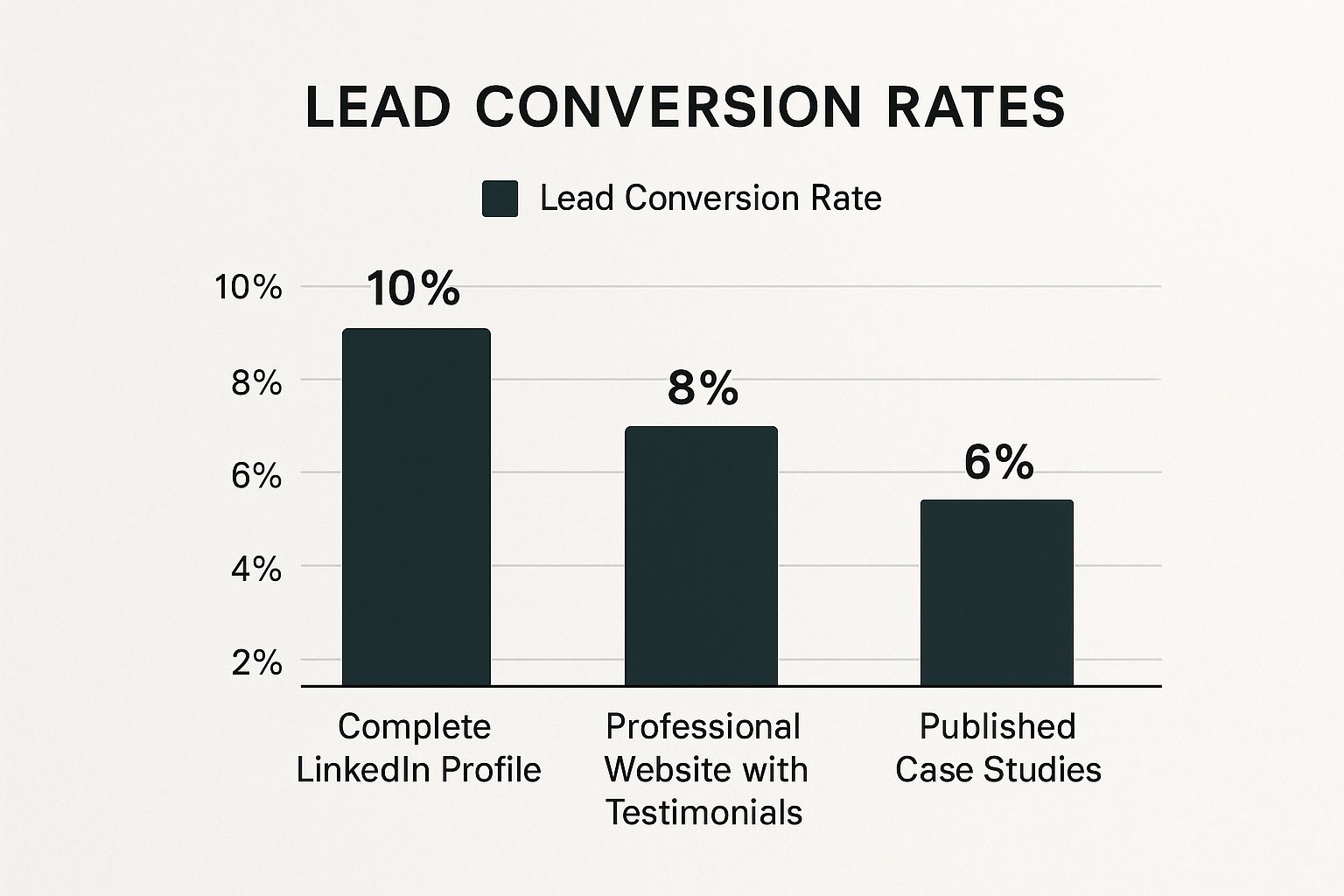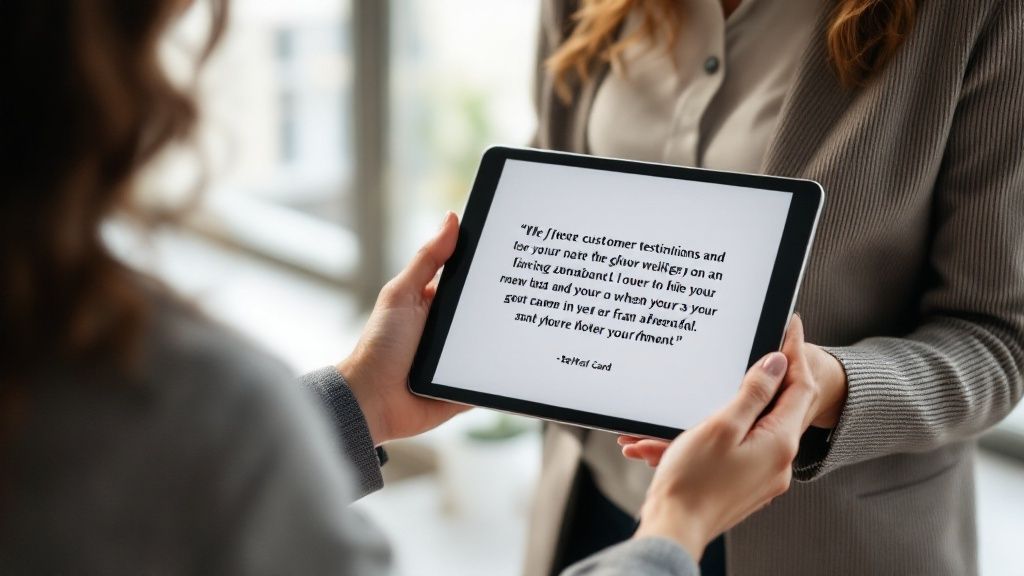Landing consulting clients begins with laying the right groundwork. This means defining precisely who you want to work with and creating an offer they can't refuse.
Getting this foundational piece right significantly impacts every marketing and sales action you take later. It’s the strategic heavy lifting you must do before you even think about outreach.
Building Your Foundation for Client Success

Before you can find and win over clients, you need absolute clarity on who you're targeting and what you’re truly offering them.
Jumping into outreach without this focus is like navigating a new city without a map—you'll wander aimlessly, wasting precious time and energy.
The first step is to move beyond vague ideas and build a detailed Ideal Client Profile (ICP). This isn't just a fuzzy picture of a dream client; it's a specific, data-backed description of the perfect customer for your consulting services. It's time to get granular.
Pinpointing Your Ideal Client
An effective ICP is built on concrete details that define your target market. Instead of a generic label like "small businesses," you need specificity: "B2B SaaS companies with 50-200 employees struggling with user retention." That level of detail makes your marketing instantly more targeted and powerful.
To build out your ICP, focus on these key elements:
- Industry and Niche: Where is your expertise deepest? Be specific—think FinTech, Healthcare IT, or e-commerce logistics.
- Company Size: Are you targeting startups, mid-market companies, or enterprise-level organizations? Define this with revenue figures and employee counts.
- Decision-Makers: Who signs the checks? Pinpoint their job title (e.g., VP of Sales, Head of Operations, Chief Marketing Officer) and understand their professional pain points.
- Pain Points: What are the specific, costly problems they face that you are uniquely positioned to solve?
Once you have a clear picture of your ideal client, you can manage these relationships far more effectively. For a deeper look, check out our guide on choosing a CRM for business development to keep your prospects organized.
Crafting Your Value Proposition
With your ICP defined, the next step is to articulate your value. Your value proposition is a clear, concise statement that explains the tangible results a client gets from hiring you. It’s the definitive answer to their unspoken question: "Why should I choose you?"
A powerful value proposition transforms your service from a discretionary expense into an essential investment. It shifts the conversation from your hourly rate to the client's return on investment.
You must think in terms of outcomes, not activities. Instead of saying, "I provide social media consulting," a much stronger value proposition would be, "I help B2C e-commerce brands increase online sales by 25% in six months through targeted social media advertising strategies."
This specific, results-driven language grabs attention and builds instant credibility, setting the stage for every client conversation to follow.
Tapping Into Your Network for Early Wins
Many new consultants get caught up chasing their first client through a complex marketing funnel. The truth is often much simpler: your first client is likely hiding in plain sight within your existing professional network.
The people who already know you, trust your judgment, and have seen your work firsthand are your most valuable assets. The goal isn't a hard sell; it's to strategically inform them of your new venture. You want to turn passive connections into active advocates for your business.
Starting the Conversation Authentically
Frame your outreach as sharing exciting news, not asking for a favor. You're not desperate for work; you're a professional updating colleagues on a new chapter.
Consider a direct message to a former coworker or manager. It feels natural because it is.
For example, you could say:
- To a former manager: "Hi [Name], hope all is well. I wanted to share that I've launched my own consulting practice, focusing on helping mid-sized tech companies streamline their customer onboarding. With your deep industry experience, I'd value any quick thoughts you might have as I get started."
- To an industry peer: "Hey [Name], it's been a while! I recently started my own consulting business specializing in project management for creative agencies. I'm really excited about it and just wanted to let you know."
These messages are casual, confident, and open the door for a conversation without putting anyone on the spot. You've planted a seed that can easily grow into a referral or a direct project.
The Power of Warm Introductions
The real magic of your network is its reach. A warm introduction to someone you don't know is one of the most effective ways to land your first few clients. That personal connection instantly cuts through the noise and skepticism that greets most cold outreach.
An introduction from a mutual contact provides immediate credibility. It ensures your email gets opened and read by a decision-maker instead of being sent to trash.
When you ask for an introduction, make it incredibly easy for your contact to say "yes." Do the work for them. Write a short, forwardable blurb about yourself and what you do that they can simply copy and paste. By removing the friction, you make them far more likely to assist you.
This isn't just theory; the numbers prove it. A staggering 60% of consulting business owners say their first client came directly from their network or a referral. That statistic, found in ConsultingSuccess.com's industry report, shows just how vital these early relationship-based strategies are.
To activate your network effectively, you need a combination of outreach and a solid online presence. The table below outlines a few channels to get the word out and start generating initial conversations.
Effective Network Activation Channels
Each of these channels offers a unique way to remind people of your skills and broadcast your new consulting focus, turning passive connections into a pipeline of opportunities.

As the image shows, a strong LinkedIn profile isn't just a digital resume; it's a lead-generation machine. When your network can clearly see what you do and who you help, they know exactly who to send your way.
If you're looking to turn your profile into a client magnet, check out our guide on how to generate more leads with your LinkedIn profile.
Establishing Authority with High-Value Content

In a crowded market, potential clients need to see your expertise, not just hear about it. High-value content is your most powerful tool for building trust and attracting qualified inbound leads. This isn't about generic blog posts; it's about creating resources that genuinely solve real-world problems for your ideal clients.
So, how do you get consulting clients this way? You listen.
Pay attention to the questions prospects ask on discovery calls. Notice the challenges they discuss in industry forums. Pinpoint the topics your competitors are overlooking. These observations are goldmines for content ideas.
Your goal is to become the go-to resource in your niche. When a potential client searches for a solution, your article, case study, or webinar should deliver the clearest, most actionable answer. This strategy positions you as a trusted advisor long before you even have a conversation.
Creating Content That Converts
The most effective content doesn't just inform; it provides tangible value and showcases your unique perspective. It proves you understand your client’s world on a deep level. The best approach is to create a few cornerstone pieces of content that act as pillars for your marketing strategy.
Consider these high-impact formats:
- In-Depth Articles: Write the definitive guide on a complex topic that keeps your clients up at night. A financial consultant could create a post on "Navigating Q4 Tax Planning for Series A Startups."
- Data-Backed Case Studies: Nothing proves your worth like results. A strong case study tells a story: it outlines the client's initial problem, the strategy you implemented, and the specific, measurable outcomes you achieved (e.g., "Reduced customer churn by 18% in 90 days").
- Informative Webinars: Host a session that teaches your audience something genuinely useful. This format allows you to connect with prospects on a more personal level and answer their questions in real-time.
By prioritizing quality over quantity, you build assets that work around the clock to establish your authority and attract qualified leads. This approach is fundamental to strengthening your overall branding and visibility.
Leveraging Your Content for Maximum Reach
Creating great content is only half the battle. Strategic distribution is what turns that content into a client-generation machine. Once you hit "publish," your work has just begun. The key is getting your content in front of the right audience on the right platforms.
For most B2B consultants, LinkedIn is a powerhouse. But don't just drop a link to your article. Pull out a key insight, a compelling statistic, or a thought-provoking question to spark a conversation. Then, engage with comments and join relevant group discussions to amplify your reach.
Your content should work for you, not the other way around. A single in-depth guide can be repurposed into a dozen different assets, saving you time while expanding your footprint.
Smart repurposing is the secret to scaling your content efforts without burning out. That one webinar you hosted can be transformed into multiple assets serving different purposes across various channels.
- From Webinar to Blog Post: Transcribe the session and flesh it out into a detailed article.
- From Blog Post to Social Media: Break down the main points into bite-sized tips for LinkedIn or Twitter threads.
- From Case Study to Presentation: Turn a powerful case study into a slide deck you can use in sales calls.
This strategy ensures you get the most mileage out of every piece you create, keeping your expertise top-of-mind and driving a steady flow of inbound inquiries.
Mastering Proactive and Personalized Outreach
If you rely solely on inbound leads, you're playing the long game. While content and networking build your reputation, they put you in a passive position. Proactive outreach is how you take control of your pipeline.
This isn't about spamming a list. It’s about hand-picking high-potential prospects and starting genuine conversations. The goal is to position yourself as an expert problem-solver from the very first interaction.
Research Before You Reach
The secret to effective outreach is shifting from a generic sales pitch to a hyper-personalized, value-first approach. Before you send an email or LinkedIn message, do your homework. This is what separates a message that gets deleted from one that gets a reply.
Forget blasting a template to a giant list. Effective outreach starts with a deep dive into a single prospect. You're looking for a specific challenge, a new company initiative, or a public goal that aligns perfectly with your expertise.
Look for conversation starters—those "triggers" that create a natural opening:
- Company News: Did they just secure a new round of funding or announce a major expansion? Growth almost always brings operational challenges you can help solve.
- LinkedIn Activity: Pay attention to what your target decision-maker posts. Are they asking questions or sharing articles about a problem you have experience with?
- Job Postings: If a company is hiring for a role related to your expertise (like a "Head of Customer Success"), it’s a huge clue. It signals investment and potential growing pains in that area.
Your research mission is to find the "why you, why now" for that specific person. A personalized message that connects your skills to their current situation proves you've done your homework and understand their world.
This detective work allows you to craft a message that resonates immediately. When you demonstrate understanding of their specific challenges, you can explain exactly how you can help—which is how you land ideal consulting clients.
Crafting Outreach That Converts
Once your research is complete, you can write a message that feels exclusive to them. Skip the long, self-serving introductions. Get straight to the point and make it about them.
A powerful outreach message needs three things:
- The Hook: Lead with your research. Mention the specific article they wrote, the company news you saw, or a shared connection. This instantly proves it’s not a template.
- The Value Proposition: Connect your expertise to their situation in one clean sentence. For example, "I saw your announcement about expanding into the EU and specialize in helping SaaS firms navigate GDPR compliance to avoid costly fines."
- The Low-Threat Call-to-Action: Don’t ask for a 30-minute call immediately. That’s a big commitment for a stranger. Instead, suggest a simple next step: "Would you be open to me sharing a few common pitfalls I've seen companies make at this stage?"
This approach respects their time and offers value upfront. Achieving this level of precision means your outreach must be in lockstep with your other go-to-market efforts. You can learn more about creating that synergy in our guide to B2B marketing and sales alignment.
When you master this proactive, personalized strategy, you stop chasing cold contacts and start creating warm, qualified leads.
Turning Conversations Into Signed Contracts

Getting a prospect on a discovery call is a significant win, but the real work is just beginning. This is your moment to shift from salesperson to trusted advisor. Your job is to diagnose their problem so thoroughly that your proposed solution feels like the only logical next step.
An effective discovery call is 100% about the prospect. You should be listening far more than you talk. Think of yourself as a detective, asking insightful questions that cut to the core of their challenges. You’re there to uncover pain points they might not even see clearly themselves.
How to Structure a Powerful Discovery Call
A well-structured call helps you gather critical information without making the prospect feel interrogated. The secret is to guide the conversation naturally across a few key territories:
- Their Current Reality: Start by understanding their situation. Ask, "Could you walk me through your current process for X?" This provides a baseline.
- The Problem Itself: Now, dig into the pain. Questions like, "What's the single biggest bottleneck this issue is creating for your team?" help quantify the problem's impact.
- Their Ideal Future: Get them to paint a picture of success. Ask, "If we were talking again in six months, what would need to happen for you to consider this project a massive success?" This aligns your solution with their vision.
- Budget and Authority: You must discuss money. Gently qualifying them with, "Have you set aside a budget for solving this?" can save everyone time and set clear expectations.
The best discovery calls feel less like a sales pitch and more like the first working session. When a prospect feels genuinely understood, they begin to see you as a partner, not just a vendor.
By the end of the conversation, you should have a crystal-clear understanding of their problem, their goals, and exactly how your solution bridges that gap. This clarity is the foundation of a proposal that sells itself.
Crafting a Proposal That Actually Closes the Deal
A winning proposal is more than a price list. It's a strategic document that proves you were listening. It should mirror the conversation you just had, using their own words to describe their challenges and desired outcomes.
Your proposal needs to be sharp, concise, and focused on value. Here’s what every proposal should include:
- The Executive Summary: Start with a punchy overview that summarizes their main problem and how you will fix it. This is for the busy decision-maker who might only skim the first page.
- The Scope of Work: Get specific here. Clearly outline every deliverable, milestone, and timeline to prevent scope creep later.
- The Investment: Always frame your pricing as an investment, not a cost. Tie your fee directly to the value and return they can expect. Make it a clear choice.
- The Next Steps: Tell them exactly what to do next. Make it simple for them to say "yes," whether that's signing a digital agreement or booking a kickoff call.
Once the contract is signed, the next phase is starting the relationship on the right foot. To nail this transition, check out our guide on client onboarding best practices. It's a critical step that sets the tone for the entire project.
Answering Your Top Questions About Landing Consulting Clients
As you delve into consulting, questions will naturally arise. Building a reliable client pipeline is the lifeblood of your business, so let's tackle some of the most common queries.
How Long Does It Realistically Take To Get Your First Client?
This is the million-dollar question, and the honest answer is: it depends.
If you have a strong professional network, you can often land a project within 30-60 days. The pre-existing trust dramatically shortens the sales cycle.
However, if you're starting from scratch with a smaller network, a 3-6 month timeframe is more realistic. This period provides the necessary runway to build authority with content, establish a rhythm with outreach, and nurture a cold lead into a signed contract.
In either scenario, the biggest factor that will speed up your timeline is consistent daily action.
What's the Biggest Mistake You See New Consultants Make?
The most common and damaging mistake is the failure to specialize.
In an attempt to appeal to everyone, new consultants offer vague services that appeal to no one. This dilutes their marketing, makes their outreach feel generic, and leaves potential clients confused about what they actually do.
A pitch like, "I help businesses grow," is instantly forgettable. In contrast, "I help B2B SaaS companies reduce customer churn by 15% through improved onboarding" immediately tells the right person you are the expert they need.
Should I Do Free Work or Offer Big Discounts To Get My First Client?
While tempting, offering a free project to get a testimonial is almost always a bad move.
Working for free devalues your expertise from the start and attracts clients who may never be willing to pay your worth. Once that precedent is set, it's incredibly difficult to transition the relationship into a paid engagement.
Instead of working for free, consider offering a small, paid discovery project. You can call it a:
- "Strategy Audit"
- "Growth Roadmap Session"
- "Systems Diagnostic"
This allows the client to experience your value at a lower price point while establishing that your expertise has a price tag. It's a low-risk "first step" for them, not a freebie for you.
How Much of My Time Should I Actually Spend on Marketing?
When you don't have clients, finding them is your full-time job. You should spend 50-75% of your workweek on sales and marketing activities, including content creation, networking, and outreach.
Crucially, you can't stop once you get busy.
After you have a few projects, you must still dedicate at least 20-30% of your time (around 8-12 hours a week) to keeping your pipeline full. This consistent effort is what breaks the "feast or famine" cycle that plagues so many consultants.
At Twelverays, we build predictable client acquisition systems for professional services firms. If you’re tired of guesswork and want to drive measurable growth for your firm, check out our data-driven digital marketing and CRM solutions.





